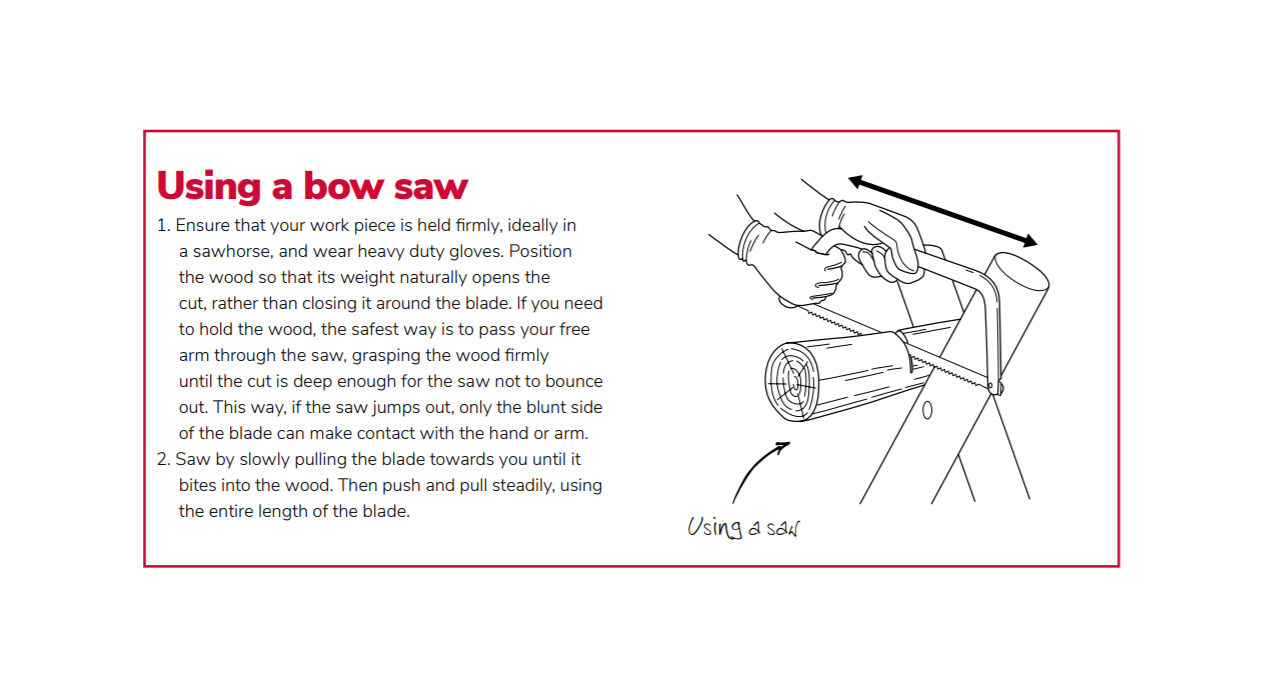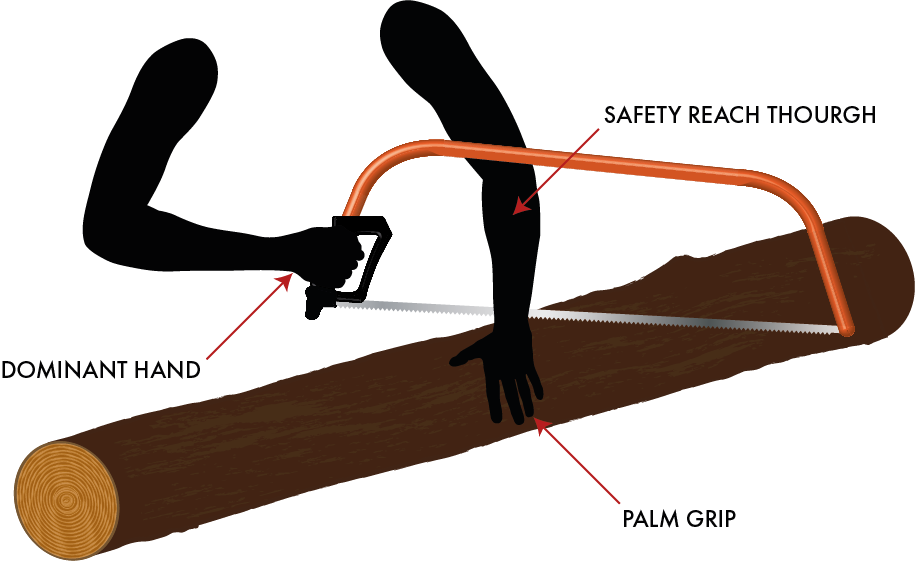Using a bow saw is essential for cutting wood efficiently. It’s a simple yet powerful tool.
A bow saw is a versatile, manual saw that can handle various types of wood-cutting tasks. From trimming branches to cutting firewood, this tool is a must-have for anyone who enjoys working with wood. Knowing how to use a bow saw correctly not only makes the job easier but also ensures safety.
In this guide, we will walk you through the steps and tips for using a bow saw effectively. Whether you are a beginner or looking to refresh your skills, understanding the proper techniques will help you get the job done right. Let’s dive into the details and make your wood-cutting tasks simpler and safer.
Introduction To Bow Saws
Bow saws are versatile tools for anyone interested in woodworking or yard work. They are simple, effective, and easy to use. This guide will help you understand the basics of bow saws. Let’s dive in.
What Is A Bow Saw?
A bow saw is a hand tool used for cutting wood. It has a thin, straight blade held in tension by a frame shaped like a bow. The blade is usually replaceable. The frame is often made of metal or wood. The design allows for smooth and quick cuts. Bow saws come in various sizes.
Common Uses
Bow saws are great for many tasks. You can use them to prune trees in your garden. They are perfect for cutting firewood. Bow saws also work well for making rough cuts in woodworking projects. They are useful for camping or outdoor activities.
Many people keep a bow saw in their tool shed. It is a handy tool for quick jobs. Even beginners can use a bow saw with ease. Safety is important, so always use gloves and eye protection.

Credit: www.youtube.com
Choosing The Right Bow Saw
Using a bow saw correctly starts with choosing the right one. The right bow saw makes cutting wood easier and faster. This section will help you pick the best bow saw for your needs.
Blade Types
Bow saws come with different blade types. Each type is suited for specific tasks. Crosscut blades are great for cutting across the grain. They have small teeth and make clean cuts. Ripping blades cut along the grain. They have larger teeth and remove more material. Choose a blade that matches your project.
Handle Design
The handle design affects comfort and control. Some handles are straight, while others are curved. Curved handles fit better in your hand. They reduce strain and improve grip. Look for handles with a rubber coating. This feature enhances comfort and prevents slipping. Select a handle that feels good in your hand.
Safety Precautions
Using a bow saw can be highly effective, but it’s crucial to follow safety precautions. Proper safety measures protect you from accidents and ensure a smooth sawing experience. Let’s explore some key safety precautions.
Protective Gear
Always wear protective gloves. They guard your hands against blisters and cuts. Safety goggles shield your eyes from flying wood chips. A dust mask helps you avoid inhaling sawdust. Sturdy footwear protects your feet from falling branches.
Safe Handling Tips
Check the bow saw for damage before each use. Ensure the blade is sharp and secure. Hold the saw firmly with both hands. Keep your fingers away from the blade’s path. Use smooth, steady strokes to cut through the wood.
Keep your work area clean. Remove any debris to prevent tripping. Always cut on a stable surface. Avoid overreaching while sawing. Stand in a balanced position.
Store the bow saw safely after use. Cover the blade to prevent accidental cuts. Keep it out of reach of children.
Basic Cutting Techniques
Using a bow saw can be rewarding. It is an effective tool for cutting wood. But it requires some basic techniques. These techniques make cutting easier and safer. Let’s explore some fundamental methods for using a bow saw. This section will cover starting the cut and maintaining control.
Starting The Cut
Begin by positioning the saw blade on the wood. Hold the saw with both hands. Ensure your stance is stable. Start with gentle, short strokes. This helps create a groove in the wood. The groove guides the saw blade. Increase the stroke length gradually. Use consistent pressure. This prevents the saw from binding. Always keep the saw blade straight.
Maintaining Control
Maintaining control is key. Keep your hands firm but relaxed. Guide the saw with smooth, even strokes. Avoid forcing the blade. Let the saw do the work. Watch your cutting line. Adjust your angle if needed. Take breaks to avoid fatigue. Fatigue can lead to mistakes. Safety goggles are essential. Protect your eyes from sawdust.
Advanced Cutting Methods
Advanced cutting methods with a bow saw can take your woodworking skills to the next level. By mastering these techniques, you can achieve cleaner, more precise cuts. Let’s explore two advanced methods: curve cuts and precision cuts.
Curve Cuts
Curve cuts allow for more artistic and complex designs. To start, choose a blade with fine teeth. This gives you better control. Begin by marking the curve on your wood. Use a pencil for clear lines. Start cutting slowly along the marked line. Keep the saw steady and move it gently. If you rush, the blade may bend or break. Always follow the curve smoothly. This ensures a clean, accurate cut. Practice makes perfect. So, don’t get discouraged with your first attempt.
Precision Cuts
Precision cuts are essential for detailed projects. Use a blade with fine, sharp teeth. This gives you more accuracy. Start by marking your cut line clearly. Use a ruler for straight lines. Hold the wood firmly in place. Begin sawing slowly along the marked line. Keep your hand steady. Make sure the blade is perpendicular to the wood. This ensures a straight cut. Check your progress often. Adjust if necessary. Precision requires patience and a steady hand. With practice, your cuts will become more accurate.
Maintaining Your Bow Saw
Maintaining your bow saw ensures it works effectively and lasts longer. Regular care helps keep the blade sharp and free from rust. Let’s discuss some key maintenance tasks.
Cleaning The Blade
Keeping the blade clean is essential for smooth cuts. After each use, wipe the blade with a clean cloth to remove sap and debris. For stubborn residue, use a mild soap and water solution.
Dry the blade thoroughly to prevent rust. Store the saw in a dry place, away from moisture. Consider applying a light coat of oil to the blade for added protection.
Sharpening Tips
A sharp blade is crucial for efficient cutting. To sharpen your bow saw, follow these steps:
- Secure the saw in a vice, with the blade facing up.
- Use a triangular file that matches the size of the saw teeth.
- File each tooth individually, following the original angle.
- Count strokes to ensure even sharpening.
- Check for burrs and remove them with a fine file.
Sharpening the blade regularly ensures clean and effortless cuts. Aim to sharpen your saw after every few uses.
| Maintenance Task | Frequency | Tools Needed |
|---|---|---|
| Cleaning the Blade | After each use | Cloth, soap, water |
| Sharpening | Every few uses | Triangular file, vice |
Regular maintenance keeps your bow saw in top condition. Clean the blade and sharpen it as needed for the best performance.
Common Mistakes To Avoid
Using a bow saw can be tricky for beginners. Many people make common mistakes that hinder their sawing. Here, we will address two major errors: improper blade tension and wrong cutting angles.
Improper Blade Tension
Blade tension is critical for effective sawing. If the blade is too loose, it will wobble. This makes cutting harder and less precise. On the other hand, if the blade is too tight, it may snap. Always check the blade tension before you start sawing. Adjust it so the blade is firm but not overly tight.
Wrong Cutting Angles
Another common mistake is using the wrong cutting angle. Holding the saw at a steep angle can make cutting difficult. It can also cause the saw to bind. The ideal angle is about 45 degrees. This allows for smooth and efficient cutting. Practice holding the saw at this angle to improve your cuts.

Credit: www.linkedin.com
Project Ideas For Beginners
Are you new to using a bow saw? Start with simple projects to gain confidence. Here are some easy project ideas for beginners. These projects will help you get comfortable with your bow saw while creating useful items.
Simple Woodworking Projects
Woodworking can be a fun and rewarding hobby. Here are a few simple projects to try:
- Birdhouse: Create a cozy home for birds. Use your bow saw to cut the wood pieces. Assemble them with nails or screws.
- Picture Frame: Make a custom picture frame. Cut the wood to size and sand the edges. Paint or stain it to your liking.
- Tool Rack: Organize your tools. Cut wooden slats and attach them to a board. Hang it in your garage or shed.
- Coasters: Craft wooden coasters for your home. Cut small, even slices from a branch. Sand them smooth and add a finish.
Gardening Tasks
Your bow saw is not just for woodworking. It can also be useful in the garden. Here are some gardening tasks you can do with a bow saw:
- Pruning: Trim tree branches and shrubs. Remove dead or overgrown limbs. This will help your plants stay healthy.
- Building Raised Beds: Cut wood to build raised garden beds. This will improve your garden’s structure and soil quality.
- Creating Plant Supports: Make stakes or trellises for your plants. Use your bow saw to cut the wood to the desired length.
- Compost Bin: Build a compost bin to recycle garden waste. Cut the wood and assemble a simple frame.
Resources For Further Learning
Learning to use a bow saw effectively requires practice and the right resources. Whether you are a beginner or looking to refine your skills, there are many ways to gain more knowledge. Here are some excellent resources for further learning.
Books And Guides
Books offer detailed information and step-by-step instructions. “The Complete Manual of Woodworking” is a great start. It includes sections on using hand tools, including bow saws. Another useful guide is “The Woodworker’s Bible” which has chapters dedicated to hand sawing techniques. Libraries and bookstores often have these resources available.
Online Tutorials
Online tutorials can be highly effective for visual learners. YouTube has many channels dedicated to woodworking. “Woodworking for Mere Mortals” is a popular channel with clear and easy-to-follow videos. Another great resource is “Paul Sellers’ Woodworking Masterclasses.” These tutorials cover a wide range of topics, including the use of bow saws. Websites like Instructables also offer step-by-step guides and community advice.

Credit: www.scouts.org.uk
Frequently Asked Questions
What Is A Bow Saw Used For?
A bow saw is used for cutting wood. It’s ideal for pruning trees and cutting logs.
How Do You Sharpen A Bow Saw?
Sharpen a bow saw by using a file. Sharpen each tooth individually, ensuring the teeth are even and sharp.
How To Maintain A Bow Saw?
Maintain a bow saw by cleaning it after use. Store it in a dry place and regularly check the blade for sharpness.
Can A Bow Saw Cut Metal?
No, a bow saw is designed for wood. Use a hacksaw or other metal-specific saw for cutting metal.
Conclusion
Using a bow saw can be straightforward and rewarding. Follow the steps carefully. Safety is vital. Wear gloves and goggles. Practice makes perfect. Start with small branches. With time, you will get better. Remember to maintain your saw. A sharp blade cuts better.
Keep it clean and rust-free. Happy sawing!
